Wrenchin’ Wednesday: DIY boost leak detector!
Tracking down boost leaks is tricky. Unlike most vacuum leaks, these won’t open up until significant pressure has accumulated, so they can’t be identified by simply dousing sealing surfaces with intake cleaner with the engine idling in the driveway. To build boost, the engine has to be running under load, and the pressure at which a leak begins to announce itself can sometimes be impossible to generate while the vehicle is stationary—and the additional cacophony of the wound-up motor can make picking out individual sounds tricky, too. Unless you’ve got a buddy who’s willing to ride on the fender like an Argentinian codriver, you’ll need a way to replicate boost pressure while the vehicle is standing still.

Today’s Wrenchin’ Wednesday is a basic boost leak tool, which plugs the air-filter side of your intake system and provides a metered way to pressurize and test for boost leaks. You’ll need an air fitting, such as this bolt-in valve stem, and a gauge of some sort to make sure that you’re not inadvertently pushing the intake system beyond its operating range. For the body of the tool, I purchased a 3-inch ABS pipe cap at my local hardware store. Bring a tape measure, because this “3-inch” plug measures 4 inches in diameter, which is what I needed for my intake piping. Why a 3-inch cap measures 4 inches in diameter is beyond me, but I guess that’s why plumbers are paid the big bucks.


I sized this plug to include the turbocharger in the boost leak test, though it may be convenient in other configurations to insert the tester after the compressor. Size your cap’s outer diameter to the inner diameter of the coupler you’ll be using to seal it to the intake. I used an 11/32 and an 13/32 drill bit to drill out ports for my valve stem and gauge, though the exact drill bit diameters for your boost leak tester will vary with the exact parts you use here. The ABS cap is thick enough for the 1/8 NPT fitting of the pressure gauge to thread in, and a little PTFE thread tape helps seal the deal.

Using the boost leak tool is as simple as fitting it to the inlet side of your forced-induction system, and then using an air-chuck to meter air into the intake until you come up to target boost. Naturally, one or more intake valves may be open, so expect boost to bleed off once the air supply has been stopped. If you can’t hit target boost, rotate the motor to see if you can find a spot where the intake valves are as closed as possible, and feel free to gut the core out of the bolt-in valve stem to allow for more air volume to past.
Lastly, be mindful if you’re testing through the turbocharger: There’s a good chance that the pressurized air will spin the compressor wheel, and prolonged spinning while the motor is off may drive the residual oil out of the center cartridge and risk bearing damage. If you’re not getting results, don’t keep endlessly trying unless you’re planning to bypass the compressor housing during the rest of the boost leak diagnostics.


